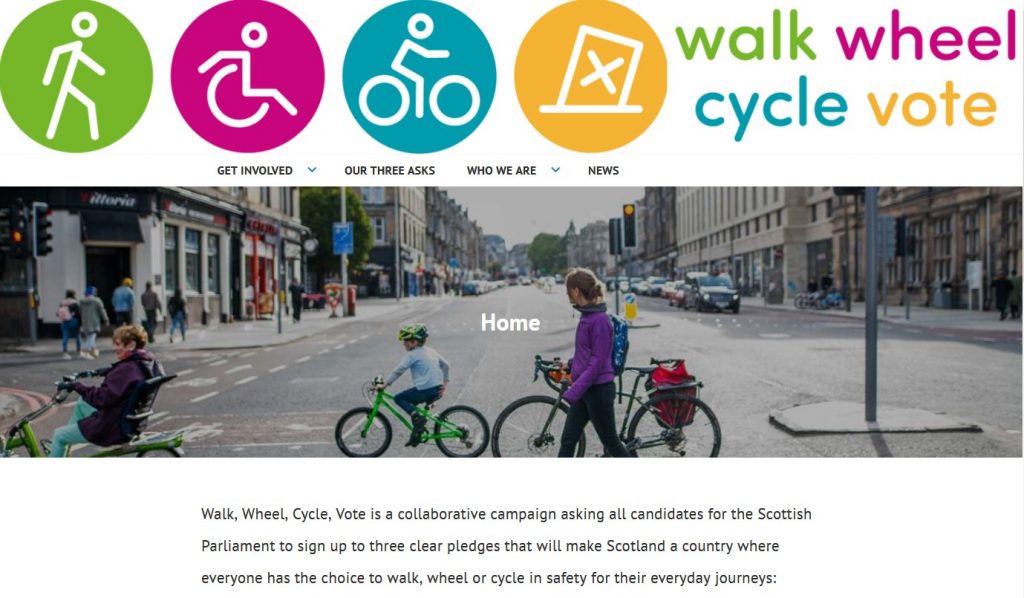Like many other Councils across Scotland and the UK, Edinburgh is consulting on whether to make successful SfP schemes permanent – and, if so, how they should be improved. Please respond to the consultation!
After the start of the covid pandemic Edinburgh, along with many other councils, began to implement a range of Spaces for People projects, with funding provided by the Scottish Government via Sustrans for this purpose. The schemes aim to assist safe outdoor exercising on foot and by bike and to enable more social distancing, including freeing up spaces on public transport.
Edinburgh won £5.25m of the government’s £39m SfP allocation – increased from an initial £10m due to the success of the scheme. Edinburgh has implemented town centre footway widenings, a remarkable 70 or so school road safety measures (several being effectively mini-LTNs) and nearly 40km of semi-segregated cycleroute on main roads.
Although introduced for covid-related reasons, many of these schemes also support a wide range of other government and local authority objectives, to increase use of active travel for reasons including climate, public health, and congestion. Spokes therefore strongly supports making all successful SfP schemes permanent, together with improvements identified by public feedback and experience.
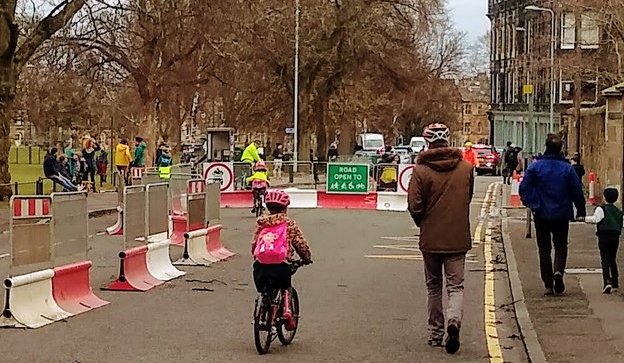
space for school – @blackfordsafer1 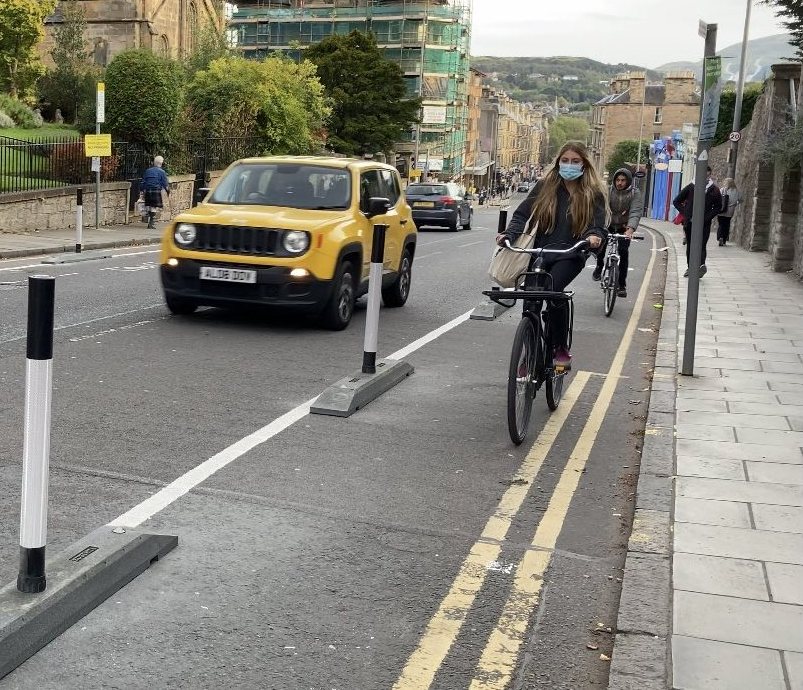
space for cycling – @johnrobson87 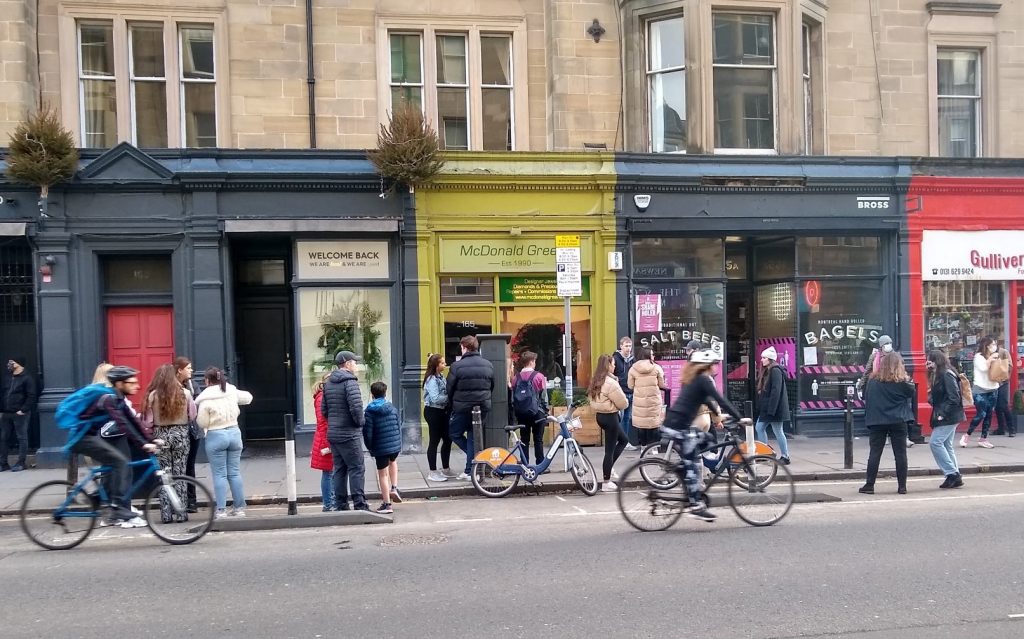
space for queuing – @porthkea 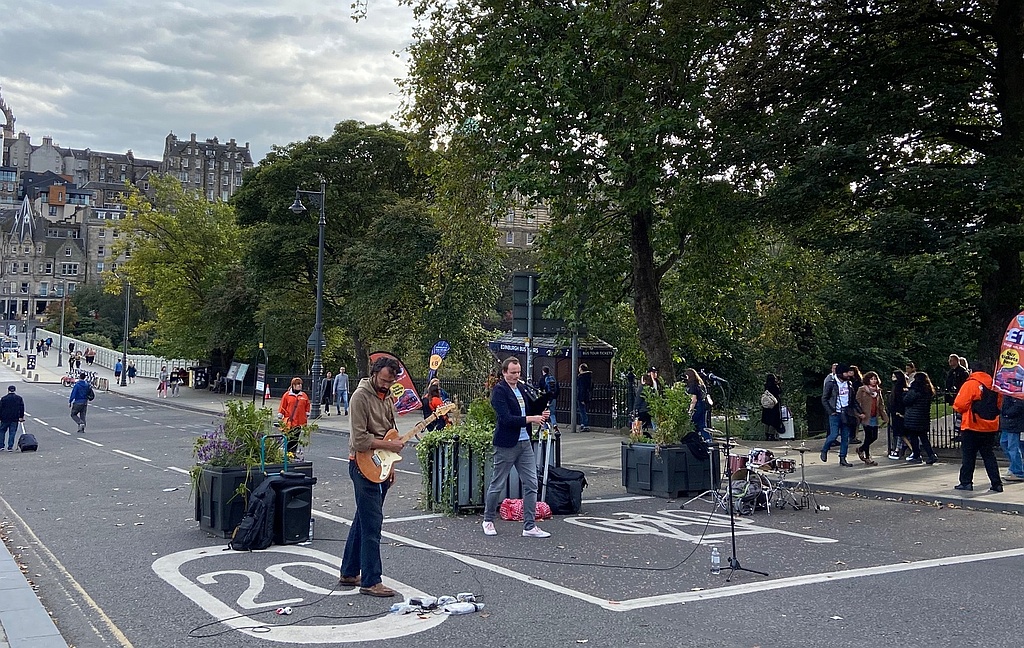
space for playing – @justacwab
Respond to the consultation – now closes 5 April
The consultation is here…
https://consultationhub.edinburgh.gov.uk/bi/retainingspacesforpeopleconsultation/
In the consultation you can select that you wish to keep ‘all or most’ schemes (or none) or you can nominate up to 5 individual schemes; and similarly if there are schemes you wish removed (we hope few or none!)
After each question there is a space for up to 60 words – you can use this space to explain how you would like schemes improved. Some of your ideas may be used to modify the existing temporary materials and others to be incorporated in future permanent infrastructure.
You can go backwards and forwards between pages of the questionnaire, and change your answers – you can even go through reading all the questions before you begin to answer any. You are also given an option to be emailed a copy of your response. Finally, once you have clicked ‘submit response’ you are finished and cannot go back any make more changes.
Please also retweet our tweet about the consultation.
Misunderstandings
Unfortunately there is a lot of misleading information around, including a petition with several very dubious claims. So here we give a few examples of the kind of points you may encounter.
“The schemes are temporary, and have never been intended to be permanent”
The Scottish Government, who fund the schemes, have been absolutely clear from the outset that councils may wish to make successful SfP schemes permanent, and that the government will help where it can. The schemes are temporary in the sense that their legal validity comes from a TTRO (Temporary Traffic Regulation Order) with a limited life, but they can be made permanent, without interim removal, through the usual legal and consultation processes (discussed further below).
The Cabinet Secretary, Michael Matheson MSP, has made this clear on countless occasions, for example in this speech (at 4:50), “I do hope that we can see a permanent lasting legacy of active travel infrastructure, as a result of the Spaces for People initiative“
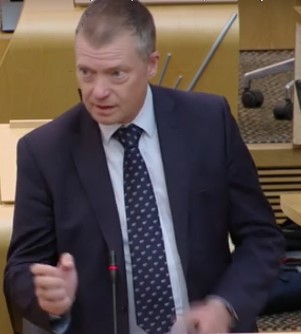
Indeed, although most of the Edinburgh political opposition to SfP is from some Conservative councillors, the Scottish Government has been asked by Conservative Transport spokesperson Graham Simpson MSP to ensure that SfP money is not wasted by removing schemes. Indeed, on 10 Feb 2021 Conservative MSP Jamie Halcro Johnston went so far as to ask the Government to simplify the processes for making schemes permanent.
We very much sympathise with Mr Halcro Johnston, since due to a labyrinthine combination of timescales and legalities many schemes will have to undergo 3 consultations; feedback on the TTRO schemes, including the present consultation, then separate consultations on an ETRO and then a TRO. The government could and should simplify the rules which result in this crazy bureaucracy, whilst still of course ensuring a final full and detailed consultation. The Scottish Parliament Cross Party Group on Cycling, Walking and Buses is urging the Cabinet Secretary to do this.
The government’s intent is re-emphasised in the recent Strategic Transport Projects Review [STPR2]…
“making these permanent where successful is the next key step in .. roadspace .. allocation & supporting active travel”
“Emergency services are delayed”
Edinburgh consults the emergency services (and operators such as buses) on all SfP schemes – we presume all councils would do this.
More generally, a FOI request [fuller details] to all 12 GB NHS Ambulance Trusts (10 replies) found that none opposed the SfP schemes, whilst 4 explicitly supported active travel schemes and none supported the withdrawal of SfP funding even though asked this explicitely.
“Traffic conditions are worsened on surrounding streets”
We do not yet know of research on SfP schemes, but Napier University Transport Research Unit reviewed 16 case studies of school streets closures (all they could find) and concluded that there were no significant road safety issues resulting, and indeed perceived safety rose on surrounding streets as well as streets within the closure zone.
Total levels of traffic (adding inside and outside the zones) fell, and where there was traffic displacement it was usually possible to take mitigating steps. Before schemes were implemented there was often considerable local concern about what would happen, but generally this largely disappeared once the scheme became operational, and opinions changed.
“The public is not being consulted”
The SfP schemes were, as advised by the Scottish Government for the SfP funding, and as implemented by other councils, installed under TTRO regulations which do not require any public consultation (emergency services are consulted). However, despite this, and with the exception of a small number of very early schemes, the Council has consulted with community councils, ward councillors and city-wide stakeholders such as Living Streets and Spokes, albeit on short timescales.
Furthermore, every scheme once installed is reviewed periodically, taking account of any feedback from the public on the basis of seeing how the scheme works in practice. Most of the schemes have rapidly settled in (as in the above pictures), many minor modifications have been made and lessons learned which could not have been easily predicted without seeing the scheme on the ground.
As explained above, in order to make any scheme permanent, legal processes for full public consultation/ objections must be followed – indeed we’d not be surprised if people start to complain about being consulted three or more times on the same project.
It is interesting to remember that, in contrast to these consultations, there is zero public consultation on the gradual processes by which our streets have been made more congested through growing numbers of cars, growing sizes or cars, and satnavs further encouraging motor traffic into residential rat-runs. These are permanent changes, with no formal public opportunities for comment or objection, and which continue to have far greater impact on our streetspace than any SfP project.
“Detail x of scheme y is a problem”
Certainly there are problems, though once a scheme is in place many fears prove to be unfounded, and conversely unforseen issues may arise. Spokes, like others, has fed back comments and suggestions, before and after implementation. As explained earlier, schemes are reviewed and modified on this basis of real experience.
It must be noted that the Spaces for People schemes are constructed using cheap and often temporary materials, as the government funding intends, in order that significant amounts of infrastructure could be installed rapidly during the pandemic.
However, schemes which are made permanent will require different forms of construction, for example full kerb separation for main road segregated cycle lanes. Such provision, however, entails considerable resourcing of time and money in design, consultation and implementation.
Therefore, whilst ETROs followed by TROs will enable the existing schemes to become legally permanent, there will have to be a gradual process, possibly over 2 or 3 years, to replace the existing temporary materials by permanent designs.
The speed of this process will depend in large part on budget decisions by the Scottish Government. Along with the Walk Wheel Cycle Vote campaign, we urge readers to ask MSPs to raise the active travel budget, rather than freezing it at current levels for the next 5 years as they currently propose.

